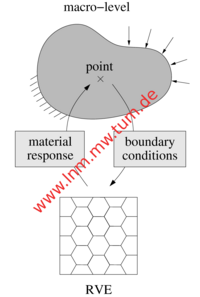Solid Dynamics: Multiscale methods
Multiscale phenomena play an important role in many problems in solid mechanics. For instance, the macroscopic behavior of multi-phase materials is governed by the morphology and the properties of their micro-constituents. To deal with this kind of problems, a plethora of homogenization methods have been developed over the last decades. These approaches aim for integrating fine-scale effects in a coarse-scale model without resolving the micro-structure completely. By combining information available on different levels, advantage can be taken of both the simplicity of a macroscopic description and the accuracy of a fine-scale model.

Our work focuses on so-called FE2 methods which are based on a finite element discretization of both macro- and micro-level problems. Each macro-level integration point is implicitly identified with a representative volume element (RVE) representing the micro-structure in its vicinity. In each time and nonlinear iteration step, the macroscopic deformation state defines boundary conditions for the associated micro-problem. After solution of the nonlinear micro-problem, the macroscopic material response (i.e. stresses and constitutive tensors) is determined by volume-averaging over the RVE. The benefit of this strategy is twofold; firstly, an improved description of the macroscopic behavior is achieved. Secondly, phenomena on the micro-level can be investigated "on the fly".
One important field of application is lung tissue modeling. To enable a reasonable investigation of lung mechanics during (mechanical) ventilation, we developed a novel FE2 approach for 3D nonlinear dynamics. This methodology is currently also utilized to deduce micro-scale material properties from macroscopic experiments in terms of a multiscale inverse analysis.
Publications
Please find publications on this topic here.